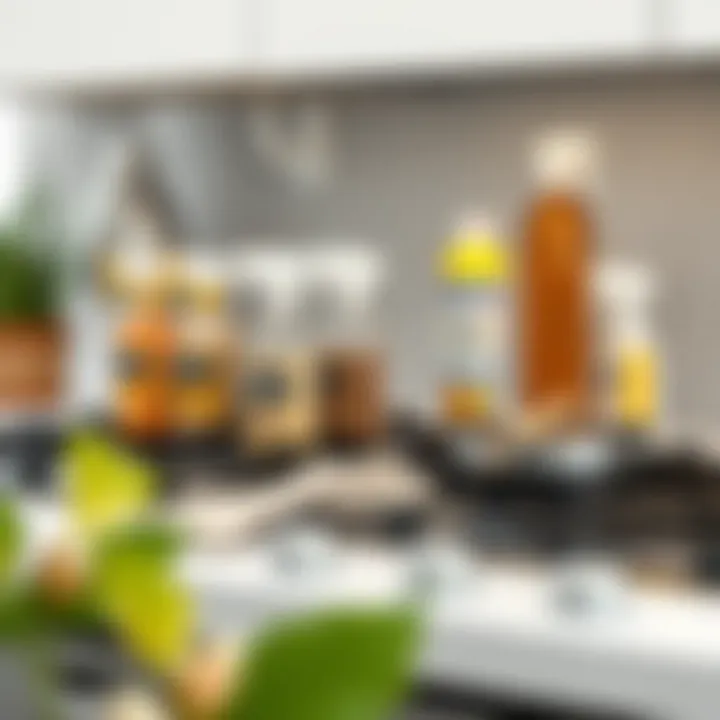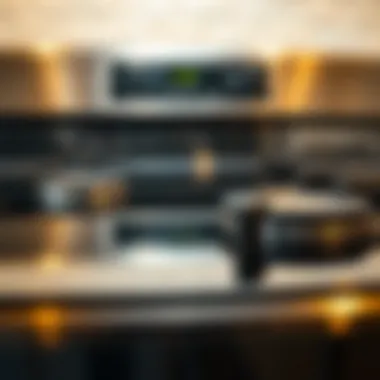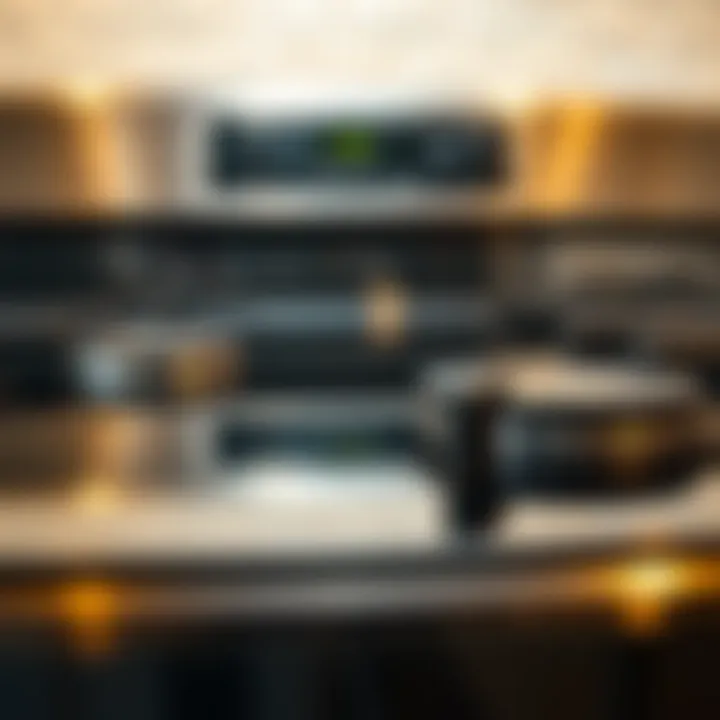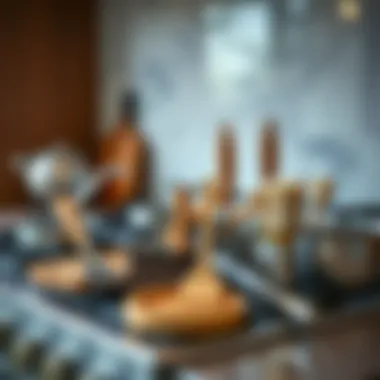Mastering the Art of Stove Top Cleaning: A Complete Guide


Intro
When it comes to our kitchens, the stove top often takes a beating. Splashes of sauce, spills of oil, and crumbs somehow always find their way to the cooktop. It's one of those spots where efficiency meets messiness, and keeping it clean can feel like an uphill battle. However, knowing how to properly clean your stove top not only improves hygiene but also enhances your cooking experience.
In this article, we delve into the nitty-gritty of stove top cleaning, discussing various materials and surfaces, the right tools for the job, and the best techniques to use. Whether you have a sleek induction cooktop or a traditional gas range, maintaining your stove can keep both its aesthetics and functionality in prime condition. A clean stove can be the centerpiece of your kitchen, a spot that showcases your culinary adventures rather than hiding them. So take a minute, roll up your sleeves, and let’s tackle this together.
We’ll explore methods tailored to fit your specific stove top style, ensuring that by the end, you’ll have a reliable roadmap for keeping your kitchen appliance shining like new.
Prelude to Stove Top Maintenance
Keeping your stove top clean is more than just a matter of aesthetics; it's about safety and efficiency in the kitchen. Regular maintenance of stove tops, regardless of the type, ensures not only a nice appearance but also their effective functioning. When food equipment is maintained properly, it can last considerably longer and operate more efficiently. Dirty stove tops can lead to uneven cooking, unpleasant odors, or even fires due to built-up grease.
Moreover, maintaining a clean stove top is essential for preventing cross-contamination during food preparation. This is particularly important for households with children or those who are health-conscious. Therefore, diving into the realm of stove top care is a significant step toward creating a safer cooking environment and enhancing your culinary adventures.
Importance of Regular Cleaning
Regular cleaning is crucial as it helps to remove remnants of food and grease that accumulate during cooking. If left unchecked, these residues can harden and become stubborn stains that are harder to remove. Not only that, but neglecting to clean can also lead to lingering smells that might affect the taste of your meals. From a hygiene perspective, a clean stove top is vital in preventing bacteria growth, which can pose health risks. For these reasons, making a habit out of cleaning the stove after each use, or at least on a weekly basis, can do wonders not just for the stove but for your food and overall kitchen environment as well.
Understanding Different Types of Stove Tops
Before delving into cleaning methods, it's essential to recognize that different stove tops require different care approaches. Understanding the material and design of your stove top will inform the best cleaning practices for maintenance.
Gas Stove Tops
Gas stove tops are popular due to their quick heat response and visual cooking control. The flames provide instant feedback on cooking temperature, contributing to precise cooking techniques. However, they can accumulate grease and food particles in hard-to-reach areas, like burners and grates. As a result, while gas stoves offer the advantage of gourmet cooking, they can also become a grease trap if not cleaned regularly. Their ease of repair is a beneficial aspect, allowing you to maintain a high level of culinary expertise.
Electric Coil Stove Tops
Electric coil stove tops have been a staple in many kitchens for a long time because they are incredibly durable and usually more budget-friendly. These stove tops heat up through electric coils and are straightforward to clean as the surface is often removable. A significant advantage is that they don’t require special cleaners, but the coils can tarnish over time, which can lead to uneven cooking if left unchecked. Being mindful of the coils' condition can prevent further complications.
Smooth-Top Electric Stove Tops
Smooth-top electric stove tops come with a sleek and modern design, making them appealing for contemporary kitchens. They heat more evenly than their coil counterparts, promoting better cooking results. However, they demand extra care in cleaning since scratching the surface can lead to irrevocable damage. The smooth surfaces are prone to staining, so timely attention is required to maintain their aesthetic appeal.
Induction Stove Tops
Induction stove tops are at the forefront of modern cooking technology, utilizing electromagnetic energy for heating. This innovative feature makes cooking faster and more energy-efficient. While they are generally easy to maintain because spills don’t burn onto the surface, these stove tops require specific cookware for efficient functioning. Awareness of how to maintain and sometimes integrate new cooking tools is necessary for ensuring a seamless cooking experience.
Understanding these differences in stove top types will aid in making informed decisions regarding both their care and your cooking techniques. Each stove type serves unique qualities that can enhance your kitchen experience when properly maintained.
Essential Tools and Materials
Cleaning a stove top effectively hinges on the right tools and materials. Having the right cleaning supplies can make all the difference, whether you're tackling a stubborn stain or performing routine maintenance. Each tool serves a unique purpose, elevating the overall cleaning process and safeguarding the performance and appearance of the stove. With a well-prepared arsenal at your fingertips, cleaning becomes a more efficient and less daunting task.
> Tip: Investing in quality cleaning supplies not only enhances the cleaning experience but also prolongs the life of your stove top.
Cleaning Solutions
Commercial Cleaners
Commercial cleaners are specially formulated products designed to tackle the tough messes that often accumulate on stove tops. Many of these cleaners contain powerful ingredients aimed at dissolving grease and breaking down burnt-on food residues. Their strength is a major draw, especially for those wanting quick and effective results. Popular options include brands like Easy-Off and Bar Keepers Friend.
One key characteristic of commercial cleaners is their convenience. They often come in spray bottles, which allows for precise application right where it’s needed. However, it’s important to consider possible downsides, such as harsh chemicals that might not align with the preferences of those prioritizing eco-friendliness or those with sensitive skin. Additionally, some of these products may also leave behind an artificial scent that could linger.


Homemade Cleaning Solutions
Homemade cleaning solutions, on the other hand, offer an alternative approach to stove top maintenance. Many of these mixtures rely on common household items, like vinegar and baking soda, making them accessible and often cost-effective. A popular example is a vinegar solution; simply mix equal parts vinegar and water in a spray bottle.
These DIY options appeal because they’re usually free from harsh chemicals, aligning with a more organic lifestyle. One unique feature of homemade solutions is their simplicity; not only are the ingredients easy to procure, but they also allow you to control the elements you’re using. However, some people find that the cleaning power of homemade remedies may not match that of strong commercial cleaners, especially for heavy-duty grime.
Eco-Friendly Options
In a world increasingly focused on sustainability, eco-friendly cleaning products have carved a niche for themselves. These cleaners are made from natural ingredients, aimed at minimizing environmental impact while still being effective. Brands like Seventh Generation and Method have become popular among environmentally conscious consumers.
The primary selling point of eco-friendly options is their non-toxic composition, making them safer for both your family and the environment. This characteristic can significantly contribute to healthier air quality in your kitchen. However, it’s worth noting that while they are often effective for everyday stains, they may not always perform as well on tough, baked-on dirt compared to traditional commercial cleaners.
Cleaning Tools
Scrub Brushes
A scrub brush is an indispensable tool in any stove cleaning kit. These brushes come in various shapes and materials, allowing you to choose the one best suited for your stove type. Their bristles are designed to withstand the pressure needed to scrub away stubborn stains without scratching surfaces.
What makes scrub brushes a beneficial choice is their ergonomic design, often featuring a comfortable grip, which aids in efficient scrubbing. However, their unique feature may also include varying stiffness, meaning you need to select wisely based on your stove’s material. Using a too-stiff brush on a delicate smooth-top, for instance, could result in unsightly scratches.
Microfiber Cloths
Microfiber cloths have garnered a reputation for their ability to pick up dust and dirt without the need for chemical cleaners. These cloths, made of tiny fibers, create a gentle yet effective surface for wiping down stove tops. They are great for both wet and dry applications, making them versatile.
The key characteristic that sets microfiber cloths apart is their ability to trap particles, which allows for thorough cleaning. Their reusable nature adds to their appeal, making them cost-effective over time. However, it’s crucial to wash them properly, as residual debris can diminish their effectiveness if not cleaned regularly.
Sponges and Scouring Pads
Sponges and scouring pads are staples when it comes to kitchen cleaning. They vary in texture, from soft ones ideal for gentle wiping to scouring pads made to tackle tough, stuck-on grime. Their versatility makes them ideal for all stove top types.
The benefit of using sponges is their dual cleaning capability; one side for gentle cleaning and another for scrubbing. However, choosing the wrong type for ceramic or glass surfaces could lead to scratches, which is a negative aspect to keep in mind.
Plastic Scrapers
Plastic scrapers are a must-have for anyone dealing with sticky or burnt residues. These tools allow you to gently lift away residues without harming the surface of your stove. Plastic scrapers are great for intricate areas that might be hard to reach with cloths or brushes.
Their unique advantage is that they provide leverage without scratching surfaces, making them essential, especially for glass or ceramic stove tops. However, one drawback is that you may need to put in a bit more elbow grease compared to abrasive scouring tools for tougher stains.
Step-by-Step Cleaning Instructions
Cleaning your stove top effectively requires a systematic approach. Each step ensures that you address the unique requirements of your stove’s material and type, which ultimately contributes to a more hygienic cooking environment. This methodical process not only makes cleaning more efficient but also helps you avoid damage to any sensitive surfaces. It can be a time-saver in your overall kitchen maintenance routine, so let’s dive into the details.
Preparation of the Stove Top
Safety Precautions
Before diving into the cleaning itself, ensuring safety is paramount. One important aspect of Safety Precautions is to always make sure the stove is completely cool. Hot surfaces can lead to burns, not to mention that any cleaning solutions applied to a hot stove can react unpredictably. It’s also wise to wear gloves, especially if you are using strong cleaners that may irritate the skin. Moreover, keep a fire extinguisher handy, as grease and other flammable residues can pose risks.
This consideration can’t be overstated; feeling secure while cleaning enables you to focus better on the task at hand. Always make sure you are working in a well-ventilated area. Not simply beneficial, but essential, this safety tip paves the way for an effective cleaning session.
Removing Cookware and Grates
A key characteristic of Removing Cookware and Grates is that it’s foundational to the cleaning process. Before you scrubs away grime, removing all pots, pans, and grates permits full access to the stove surface, allowing for comprehensive cleaning. Not only does this improve the cleaning process, but it also supports a systematic approach to maintaining hygiene.
Failing to take this step might leave behind stubborn food deposits and grime in unreachable areas, eventually becoming a source of bacteria. Hence, it is wise to view this action as an investment in long-term cleanliness rather than a mere chore.


Cleaning Techniques for Different Stove Types
Cleaning a Gas Stove Top
Cleaning a gas stove top requires special attention, primarily due to the presence of burners and grates. Disassembling these parts for individual cleaning is essential. It offers a thorough way to ensure that all cracks and crevices are free of food particles. A gentle scrub with a baking soda and water paste can handle the stubborn burnt spots quite effectively. This method is practical and cost-effective, aligning well with the ethos of efficient household care.
The advantage of cleaning gas stovetops in this way is that you're not only maintaining a clean surface but also ensuring the burners function effectively without blockages.
Cleaning Electric Coil Stove Tops
For Electric Coil Stove Tops, the approach is slightly different. It’s important first to unplug the unit for safety. Cleaning the coils directly is quite easy with a damp cloth and mild cleaner. One unique feature of this type of stove is its ability to engage with higher heat. However, accumulated grease can hinder performance. Thus, regular cleaning after meals becomes not just a recommendation but a necessary routine for prolonged life of the product.
The key characteristic here is the ease of access; you can quickly pull the coils off for a deeper clean. This simplicity is why it’s often a preferred choice for many homeowners.
Cleaning Smooth-Top Electric Stove Tops
Smooth-top electric stoves present distinct advantages, but they also require specific cleaning techniques to avoid scratches. A special cleaner designed for ceramic or glass surfaces will aid in breaking down tough stains without causing damage. One must be diligent and only use non-abrasive pads when cleaning to keep the surface pristine.
This careful cleaning not only preserves the aesthetic appeal but also contributes to a better cooking experience on such surfaces. The smooth, continuous glass enables easier cooking, which makes the time taken for proper maintenance worthwhile.
Cleaning Induction Stove Tops
Induction stove tops are undoubtedly high-tech, requiring thoughtful handling. The unique characteristic of an induction stove is that it only heats up when cookware is present. Consequently, it’s crucial to clean any spills immediately to avoid any residual burnt marks. A simple mixture of vinegar and water works wonders for this type of stove. It is both effective and eco-friendly, aligning nicely with modern kitchen philosophies.
The edge here is that the precise energy induction systems run best when clean. So while cleaning might seem like an extra chore, it's actually an investment in the stove's efficiency and durability.
By following these systematic cleaning instructions, cleaning your stove tops can become a more manageable task. Whether dealing with gas, electric coils, smooth-top electric, or induction, each step is designed to ensure a spotless and well-maintained kitchen centerpiece.
Dealing with Tough Stains
Cleaning your stove top can sometimes feel like trying to dig yourself out of a hole. It isn't just about regular maintenance; the reality of cooking means that tough stains can crop up—often at the least convenient times. Addressing these stains is crucial for both the aesthetic appeal and hygienic condition of your kitchen. Tough stains can harbor bacteria, cause unpleasant odors, and distract from an otherwise pristine cooking space. So, it's not just tackling the mess; it’s crucial for maintaining a clean and inviting kitchen.
Identifying Common Stains
Burnt Food Residue
Burnt food residue is the bane of many home cooks. You know the feeling: you turn your back for just a moment, and suddenly the lovely stir-fry you were preparing has transformed into a charred mess. This residue is often tough and stubborn, adhering tightly to your stove top. One key characteristic of burnt food residue is its dark color, which can starkly contrast against the gleaming surface of a stove. It’s a common issue, making it a worthy mention in this guide. The unique feature of burnt food is how it can become carbonized with prolonged exposure to heat, presenting a challenge when you’re trying to restore that shiny finish. In this article, understanding how to remove it effectively can mean the difference between a functional cooking space and one that feels like a chore to clean.
Grease Stains
Grease stains are another frequent adversary found in kitchens. They sneak up on you, usually as a result of splatters during cooking. The key characteristic of grease stains is their slick texture, making them feel resistant to traditional cleaning methods. This article highlights grease stains as an important issue because dealing with them correctly can significantly enhance cleanliness and safety in the kitchen. Not only do they look unsightly, but they can also become a fire hazard if ignored for too long. Their unique feature lies in their ability to attract dirt and grime, making regular housekeeping essential to combat their presence.
Spills and Scorches
Spills and scorches represent a combination of emergencies that occur during the cooking escapade. These happen when liquids spill over or when a pot is left unattended, leading to scorched surfaces. The significance of spills and scorches in this cleaning guide highlights how quickly when cooking, chaos can ensue. Their common characteristic is a sticky, sometimes burnt texture which can be difficult to remove. One unique aspect of spills is their range; it could be sauce, oil, or anything in between. The downside is that, if not addressed promptly, they can harden and create a bigger mess. Understanding their implications will help you maintain a cleaner and welcome environment in your kitchen.
Effective Removal Strategies
Using Baking Soda
Baking soda is often hailed as a magical cleaning agent. Its slightly abrasive nature makes it effective for scrubbing away stubborn stains without scratching the surface. One of its significant advantages lies in its natural properties, making it a safe choice in homes with children and pets. This guide stresses using baking soda because it’s not only effective but also affordable and available in most kitchens. The unique feature of baking soda is that when mixed with water, it forms a paste that can cling to stubborn stains, allowing for better penetration and removal. However, be aware that too much pressure can still scratch your surface, so gentle cleaning is always the way to go.
Employing Vinegar Solution
Vinegar is another versatile option that pairs well with various cleaning tasks. An aspect worth discussing is its acidic nature, which works effectively to break down tough stains, particularly grease. The guide highlights this because vinegar is a popular choice for those who prefer eco-friendly options in their cleaning routines. Applying a vinegar solution can dissolve scorch marks and lift stubborn grease stains like nobody's business. A unique feature of vinegar is that it also has antibacterial properties, providing an additional benefit for ensuring a hygienic cooking space. Just remember that the smell can be off-putting for some, so a fan running or quick window opening may be needed after use.


Applying Commercial Removers
For those who have tried the baking soda and vinegar duo and still find stubborn stains lingering, commercial cleaners may be the answer. These products are formulated for tough stains and can eliminate residues that traditional methods might leave behind. One key characteristic of these cleaning agents is their strength, making them ideal for tough challenges. This article includes this option because it provides an accessible solution for busy cooks who may not have the time or inclination to create homemade concoctions. The downside is that some commercial products may contain harsh chemicals, which aren’t always desirable. It's important to read labels carefully and seek out brands that offer effective products without compromising safety.
"Your kitchen is the heart of your home; keeping it clean is a chore, but it's well worth the effort for a warm and inviting space."
Understanding these various stains and employing effective removal strategies is critical. With the right knowledge at your disposal, tackling tough stains will become a more manageable part of your cleaning routine.
Preventive Measures and Maintenance Tips
When it comes to your stove top, prevention is a whole lot easier than cleanup. Regular maintenance can save you a hefty amount of time and effort in the long run, all while keeping your cooking space looking spick and span. Preventive measures not only enhance the lifespan of the appliance but also ensure it functions safely and efficiently. Here, we dive into a couple of crucial strategies: a daily care routine and long-term maintenance advice.
Daily Care Routine
Establishing a daily care routine is like having a solid game plan before you hit the field. Every time you cook, little splashes and spills can occur. If left unchecked, they turn into stubborn stains or even more serious problems. A swift wipe-down after use prevents debris buildup. Here are a few steps you might want to include in your daily routine:
- After Cooking: Allow the stove to cool down a bit. Then, use a damp cloth or sponge to wipe down the surface. This removes leftover food particles and grease without having to scrub hard later when things harden up.
- Spot Cleaning: Address any spills immediately. If a pot boils over, don’t wait for it to dry. Instead, grab your trusted cleaner—be it a natural solution or commercial cleaner—and get on it while it’s fresh.
- Daily Inspection: Take a moment to glance over the stove. Look for any signs of wear and tear or areas that need special attention. This makes it easier to tackle the issues before they escalate.
The bottom line? A little bit of time each day goes a long way in keeping things shipshape.
Long-Term Maintenance Advice
Keeping your stove top gleaming isn’t just about the here and now. Long-term strategies are essential for preserving the appliance’s integrity and aesthetic appeal. This section breaks down key aspects: regular inspections and seasonal deep cleaning.
Regular Inspections
Regular inspections are telling like the canary in the coal mine. This simple practice helps catch potential issues before they become bigger headaches. By checking your stove top at least once a month, you can keep an eye on:
- Loose Parts: Make sure grates and knobs are functioning as they should, as loose parts can lead to malfunctions or even accidents.
- Signs of Damage: Look for any cracks, discoloration, or buildup that could signal more serious problems down the road.
One compelling thing about regular inspections is how proactive they are. They not only allow you to address small issues but also familiarize you with your stove’s condition over time. After all, you wouldn't want to find out something's wrong when you're in the middle of a big family dinner!
Seasonal Deep Cleaning
Deep cleaning might feel like pushing a boulder uphill, but it’s essential to maintaining your stove's long-term health. Every season, set aside some time to roll up your sleeves and tackle a comprehensive deep clean. During this process:
- Remove Everything: Detach the removable parts, such as grates, burners, and knobs, and give them a thorough wash. Not just any rinse, but a good scrub to eliminate built-up grime.
- Use Appropriate Cleaners: Depending on your stove type, using the right cleaners can prevent damage. For example, glass top cleaners for smooth surfaces and heavier degreasers for gas stoves.A unique feature of seasonal deep cleaning is it sets a higher standard for cleanliness without feeling like a daily chore. The satisfaction from a pristine stove top can’t be overstated. However, proper planning and commitment are necessary to undertake this task, as it often involves some elbow grease.
Epilogue
Cleaning your stove top might seem like a mundane chore, but it actually bears great significance on multiple fronts. First and foremost, it contributes to hygiene in your kitchen, where food is prepared. A clean stove top helps to prevent cross-contamination and keeps your cooking area safe. Cooking enthusiasts are often meticulous when it comes to their appliances, and a spotless stove top can enhance not only the aesthetic appeal of the kitchen but also its functionality.
The article has traversed various essential elements regarding stove top cleaning. From the different types of stove tops and the necessary tools for effective cleaning, to tackling stubborn stains, each section reinforces the importance of a proactive approach to maintenance. Regular cleaning routines can spare you considerable effort down the line, preventing the buildup of harsh stains that seem to appear overnight.
In summation, embracing a consistent cleaning habit leads to a more inviting kitchen environment and extends the life of your stove top. Not only does it preserve the aesthetic integrity of your appliances, but it also nurtures a healthier cooking space. The investment of time in cleaning pays dividends in terms of longevity and efficiency.
"A clean kitchen is a happy kitchen."
Summarizing Key Points
To encapsulate the key points discussed:
- Regular Cleaning: Establish a routine to prevent grime buildup.
- Know Your Stove Type: Familiarize yourself with the specific cleaning requirements for gas, electric coil, smooth-top, and induction stove tops.
- Right Tools Matter: Equip yourself with the right cleaning tools—scrub brushes, microfiber cloths, and appropriate cleaners for best results.
- Tackle Tough Stains Promptly: Identify types of stains early on and apply effective removal strategies.
- Preventive Maintenance: Regular inspections and seasonal deep cleaning are crucial for long-term care.
Ultimately, an informed approach to stove top cleaning fosters not just cleanliness but also respect for your cooking space and gadgets.
Final Thoughts on Stove Top Care
When it comes to stove top care, remember this: it's not merely about cosmetic appeal. The diligent cleaning and maintenance schedule not only saves time but also enhances your cooking experience. Your stove top can often be the unsung hero of your kitchen. By treating it with care, you're acknowledging its role in your culinary adventures.
Investing in the right products, learning the nuances of cleaning, and integrating preventive measures creates a harmonious environment that allows for creativity in the kitchen. The result? A more efficient cooking experience and a stove that not only looks good but functions optimally. Taking the time to maintain your stove top is an act of respect to both your culinary tools and your health.



